BOTANY FOR YOUNG PEOPLE AND COMMON SCHOOLS
How Plants Grow
A Simple Introduction to Structural Botany
by Asa Gray
Originally published in 1858 and now in the public domain.
CHAPTER I.
HOW PLANTS GROW, AND WHAT THEIR PARTS OR ORGANS ARE.
SECTION IV. -- Different Forms or Kinds of Roots, Stems, and Leaves (page 3 of 3).
81. The Organs of Vegetation, or those that have to do with the life and growth of a plant, are only three, Root, Stem, and Leaf.
And the plan upon which plants are made is simple enough. So simple and so few are the kinds of parts that one would hardly expect plants to exhibit the almost endless and ever-pleasing diversity they do. This diversity is owing to the wonderful variety of forms under which, without losing their proper nature, each of these three organs may appear.
82. The study of the different shapes and appearances which the same organ takes in different plants, or in different parts of the same plant, comparing them with one another, is called Morphology and is one of the most interesting parts of Botany.
But in this book for young beginners, we have only room to notice the commonest forms, and those very briefly, although sufficiently to enable students to study all common plants and understand botanical descriptions. Those who would learn more of the structure and morphology of plants should study the Lessons in Botany.
1. Of Roots. CLICK HERE
2. Of Stems. CLICK HERE
§ 2. Of Leaves.
119. Leaves exhibit an almost endless variety of forms in different plants, and their forms afford easy marks for distinguishing one species from another. So the different shapes of leaves are classified and named very particularly, which is a great convenience in describing plants, as it enables a botanist to give a correct idea of almost any leaf in one or two words. We proceed to notice some of the principal kinds.

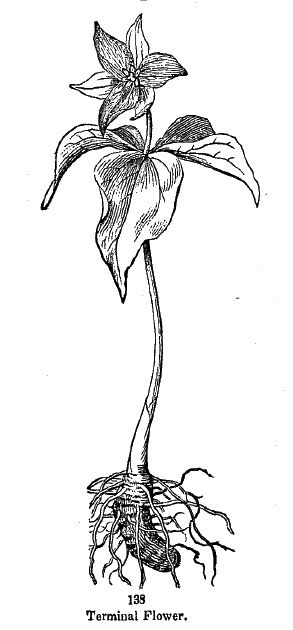
120. Their Parts. A leaf with all its parts complete has a Blade, a Footstalk, and a pair of Stipules at the base of the footstalk.
Fig. 82 shows all three parts in a Quince-leaf: b, the blade, p, the footstalk, and st, the stipules, looking like a pair of little blades, one on each side of the stalk.
But many leaves have no stipules; many have no footstalk, and then the blade sits directly on the stem (or is sessile), as in Fig. 138.
Some leaves even have no blade; but this is uncommon; for in foliage the blade is the essential part. Therefore, in describing the shape of leaves, it is always the blade that is meant, unless something is said to the contrary.
121. Leaves are either simple or compound. They are simple when the blade is all of one piece; compound, when of more than one piece or blade.
Fig. 128 to 132, and 133, are examples of compound leaves, the latter very compound, having as many as eighty-one little blades.
122. Their Structure and Veining. Leaves are composed of the same two kinds of material as stems (110), namely, of wood or fibre, and of cellular tissue. The woody or fibrous part makes a framework of ribs and veins, which gives the leaf more strength and toughness than it would otherwise have.
The cellular tissue forms the green pulp of the leaf. This is spread, as it were, over the framework, both above and below, and supported by it; and the whole is protected by a transparent skin, which is termed the Epidermis.
123. Ribs. The stouter pieces or timbers of the framework are called Ribs.
In the leaf of the Quince (Fig. 82), Pear, Oak (Fig. 120), &c. there is only a single main rib, running directly through the middle of the blade from base to point; this is called the Midrib. But in the Mallow, the Linden (Fig. 83), the Maple (Fig. 84), and many others, there are three, or five, or seven ribs of nearly the same size.
The branches of the ribs and the branchlets from them are called
124. Veins and Veinlets. The former is the general name for them; but the finest branches are particularly called Veinlets.
Straight and parallel veins or fine ribs, like those of Indian Corn, or of any Grass-leaf, or of the Lily of the Valley (Fig. 3, 85), are called Nerves. This is not a sensible name, for even if in some degree like the nerves of animals in shape, they are not in the least like them in use.
Nor are what we call veins to be likened particularly to the blood vessels of animals. But this name is not so bad, for the minute fibres which, united in bundles, make up the ribs and veins, are hollow tubes, and serve more or less for conveying the sap.
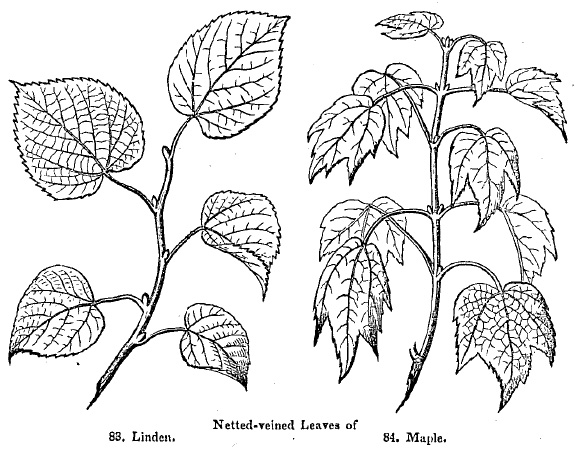
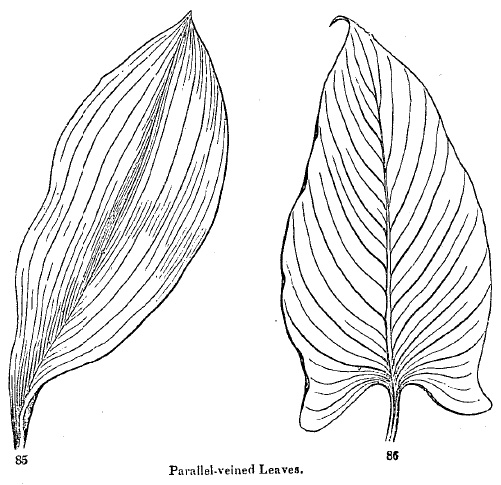
125. As to the veining, or the arrangement of the framework in the blade, leaves are divided into two classes, viz., 1st, the Netted-veined or Reticulated, and, 2d, the Parallel-veined or Nerved.
126. Netted-Veined or Reticulated leaves are those in which the veins branch off from the rib or ribs, and divide again and again, and some of the veins and veinlets run into one another, so forming reticulations or meshes of network throughout the leaf.
This is shown in the Quince-leaf (Fig. 82), and also in the Linden or Basswood (Fig. 83), and the Maple (Fig. 84), where the finer meshes appear in one or two of the leaves.
127. Netted-veined leaves belong to plants which have a pair of seed-leaves to their embryo (48) and stems of the exogenous structure (115). That is, these three kinds of structure, in embryo~ stem, and leaf, generally go together.
128. Parallel-veined or Nerved leaves are those in which the ribs and veins run side by side without branching
(or with minute cross-veinlets, if any) from the base to the point of the blade, as in Indian-Corn, Lily of the Valley (Fig. 85), &c., or sometimes from the midrib to the margins, as in the Banana and Calla (Fig. 86). Such parallel veins have been called Nerves, as just explained (124). Leaves of this sort belong to plants with one cotyledon to their embryo (47) and with endogenous stems (113).
129. Parallel-veined leaves, we see, are of two sorts: 1. those with the veins or nerves all running from the base of the leaf to the point (Fig. 85), and, 2. those where they mostly rum from the midrib to the margin, as in Fig. 86.
Netted-veined leaves likewise are of two sorts, the Feather-veined and the Radiate-veined.
130. Feather-veined (also called pinnately veined) leaves are those in which the main veins all spring from the two sides of one rib, viz. the midrib, like the plume of a feather from each side of the shaft. Figures 82, 88-97, 120, 122, &c. represent feather-veined leaves.
131. Radiate-Veined (also called palmately veined) leaves are those which have three or more main ribs rising at once from the 'place where the footstalk joins the blade, and commonly diverging like rays from a centre, the veins branching off from these. Of this sort are the leaves of the Maple (Fig. 84), Mallow, Currant, Grape-Vine, and less distinctly of the Linden (Fig. 83). Such leaves are generally roundish in shape. It is evident that this kind of veining is adapted to round leaves, and the other kind for those longer than wide.
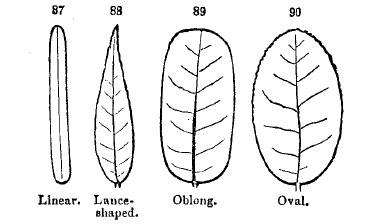
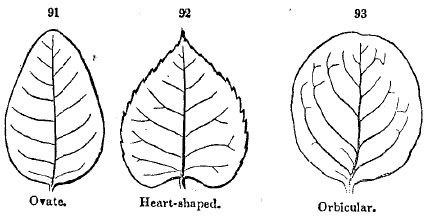
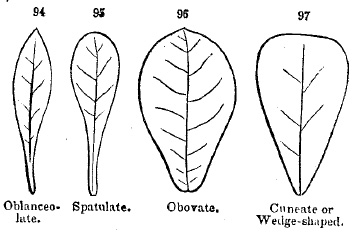
132. Shapes of Leaves. As to general shape, the following are the names of the principal sorts. (It will be a good exercise for students to look up examples which fit the definitions.)
Linear: narrow, several times longer than wide, and of about the same width throughout, as in Fig. 87.
Lance-shaped or Lanceolate: narrow, much longer than wide, and tapering upwards, or both upwards and downwards, as in Fig. 88.
Oblong: two or three times longer than broad, as in Fig. 89.
Oval: broader than oblong, and with a flowing outline, as in Fig. 90.
Ovate: oval, but broader towards the lower end; of the shape of a hen's egg cut through lengthwise, as in Fig. 91.
Orbicular or Round: circular or nearly circular in outline, as in Fig. 93.
133. Some leaves taper downwards more than upwards. Of these the commonest forms are the Oblanceolate, or Inversely lance-shaped; that is, shaped like a lance with the point downwards, as in Fig. 94.
Spatulate: roundish above, and tapering into a long and narrow base, like the old form of the apothecary's spatula, Fig. 95.
Obovate or Inversely ovate: that is, ovate with the narrow end at the bottom of the leaf, as in Fig. 96.
Cuneate or Wedge-shaped: like the last, but with the sides narrowing straight down to the lower end, in the shape of a wedge, as in Fig. 97.
134. Of course these shapes all run into one another by imperceptible degrees in different cases. The botanist merely gives names to the principal grades. Intermediate shapes are described by combining the names of the two shapes the leaf in question most resembles. For example,
Lance-linear or linear-lanceolate means between linear and lance-shaped.
Lance-oblong or oblong-lanceolate means between oblong and lanceolate in shape.
Ovate-lanceolate, between ovate and lance-shaped, and so on.
135. Or else a qualifying word may be used, as somewhat ovate, slightly heart-shaped, and the like. Thus, Fig. 92 is ovate in general form, but with the base a little notched, i.e., somewhat heart-shaped. It is one of the kinds which depend upon
136. The shape at the base. This is concerned in all the following sorts —

Heart-shaped or Cordate, when of the shape in which a heart is painted, the base having a recess or notch, as in Fig. 98.
Kidney-shaped or Reniform, like heart-shaped, but rounder, and broader than long, as in Fig. 99.
Auricled or Eared, having a small projection or lobe on each side at the base, like a pair of ears, as in Fig. 101.
Arrow-shaped or Arrow-headed, when such lobes at the base are pointed and turned backwards, like the base of an arrow-head, as in Fig. 100.
Halberd-shaped or Hastate, when such lobes point outwards, giving the whole blade the shape of the halberd of the olden time, as in Fig. 102.
Shield-shaped or Peltate, when the footstalk is attached to some part of the lower face of the blade, which may be likened to a shield borne by the hand with the arm extended.
Fig. 104 represents the shield-shaped leaf of a Water-Pennywort. Fig. 103 is the leaf of another species, which is not shield-shaped. A comparison of the two shows how the shield-shaped leaf is made.

137. As to the Apex or Point, we have the following terms, the first six of which apply to the base as well as to the apex of a leaf —
Pointed, Taper-pointed, or Acuminate, narrowed into a tapering tip, as in Fig. 105.
Acute, ending in an acute angle, Fig. 106.,
Obtuse, ending in an obtuse angle, or with a blunt or rounded apex; as in Fig. 107.
Truncate, as if cut off square at the apex, as in Fig. 108.
Retuse, having a blunt or rounded apex slightly indented, as in Fig. 109.
Emarginate or Notched, as if a notch were cut out of the apex, Fig. 110.
Obcordate or Inversely heart-shaped, that is, with the strong notch at the apex instead of the base, as in Fig. 111 and the leaflets of White Clover.
Cuspidate, tipped with a rigid or sharp and narrow point, as in Fig. 112.
Mucronate, abruptly tipped with a short and weak point, like a small projection of the midrib, as in Fig. 113.
Awned, Awn-pointed, or Aristate, tipped with a long bristle-shaped appendage, like the beard (awn) of Oats, &c.
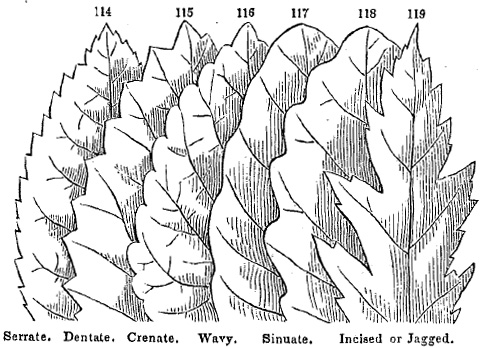
138. As to the margin, whether whole, toothed, or cut, leaves are said to be
Entire, when the margin is an even line, as in Fig. 99 to 102.
Toothed, when beset with teeth or small indentations; of this there are two or three varieties, as,
Serrate or Saw-toothed, when the teeth turn forwards, like those of a saw, as in Fig. 114.
Dentate, when they point outward, as in Fig.115.
Crenate, when scalloped into broad and rounded teeth, as in Fig. 116.
Wavy (Repand or Undulate), when the margin bends slightly in and out, as in Fig. 117.
Sinuate, strongly wavy or sinuous, as in Fig. 118.
Incised or Jagged, cut into deep and irregular jagged teeth or incisions, as in Fig. 119. This leads to truly
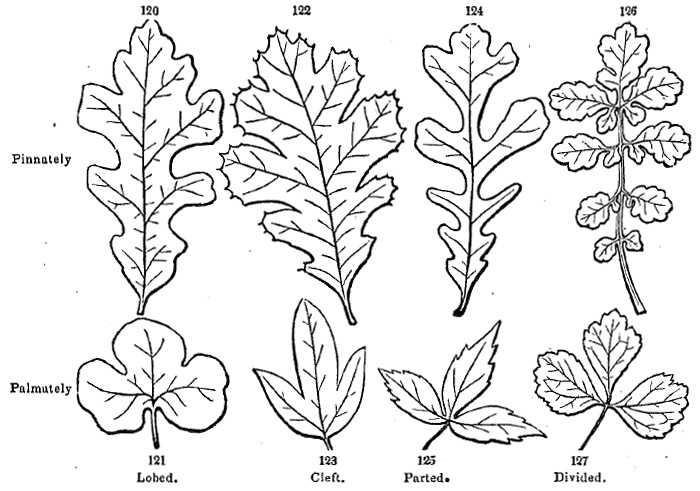
139. Lobed or Cleft Leaves &c., those with the blade cut up, as it were, into parts, i.e., lobes or divisions.
In a general way, such leaves are said to be lobed, and the number of projecting parts, or lobes, may be expressed by saying two-lobed, three-lobed (Fig. 121), &c., according to their number. Or, more particularly, a leaf is
Lobed, when the pieces are roundish, or the incisions open or blunt, as in Fig. 120, 121, and
Cleft, when cut about half-way down, with sharp and narrow incisions, as in Fig. 122, 123, and so two-cleft, three-cleft, five-cleft, &c., according to the number.
Parted, when the cutting extends almost through, as in Fig. 124, 125. And we say two-parted, three-parted, &c., to express the number of the parts.
Divided, when the divisions go through to the base of the leaf (as in Fig. 127), or to the midrib (as in Fig. 126), which cuts up the blade into separate pieces, or nearly so.
140. As the cutting is always between the veins or ribs, and not across them, the arrangement of the lobes depends upon the kind of veining.
Feather-veined leaves have the incisions all running in towards the midrib (as in the upper row of figures), because the principal veins all spring from the midrib;
while radiate or palmately veined leaves have them all running towards the base of the blade, where the ribs all spring from the footstalk, as in the lower row of figures. So those of the upper row are called pinnately lobed, cleft, parted, or divided, as the case may be,
and those of the lower row palmately lobed, cleft, &c. The number of the lobes or pieces may also be expressed in the same phrase. Thus, Hepatica has a palmately three-lobed leaf (Fig. 121); the Red Maple a palmately five-cleft leaf (Fig. 84), and so on.
141. In this way almost everything about the shape and veining of a leaf may be told in very few words.
How useful this is will be seen when we come to study plants to find out their names by the descriptions.
142. All these terms apply as well to the lobes or parts of a leaf, when they are themselves toothed, or lobed, or cleft, &c. And they also apply to the parts of the flower, and to any flat body like a leaf. The language of Botany which the student has to learn does not require so very many technical words as is commonly supposed.
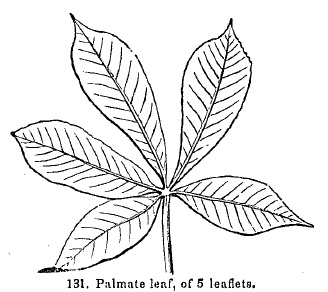
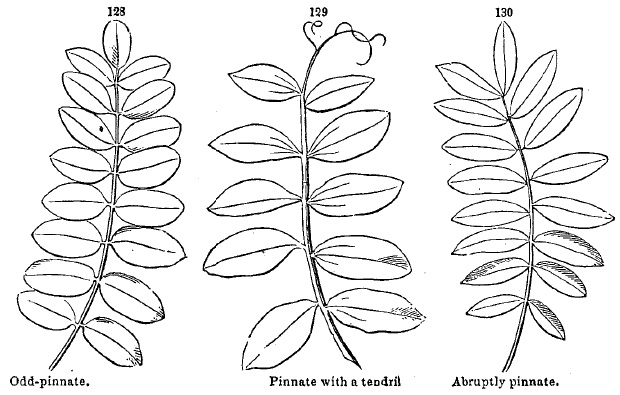
143. Compound Leaves (121) are those which have the blade cut up into two or more separate smaller blades.
The separate blades or pieces of a compound leaf are called Leaflets.
The leaflets are generally jointed with the main footstalk, just as that is jointed with the stern, and when the leaf dies the leaflets fall off separately.
144. There are two kinds of compound leaves, the pinnate and the palmate.
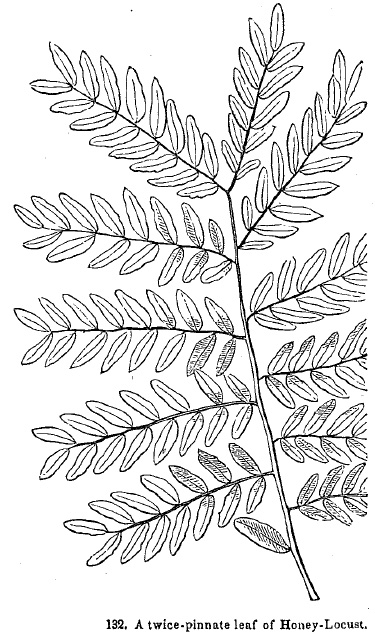
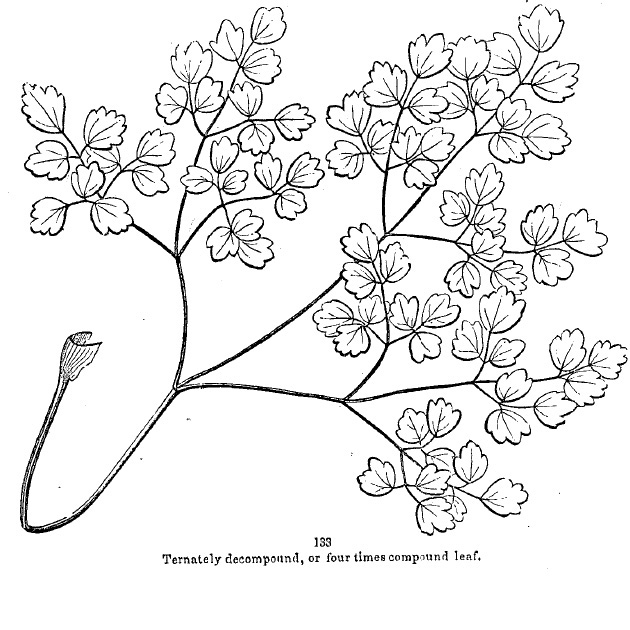
145. Pinnate leaves have their leaflets arranged along the sides of the main footstalk, as in Fig. 128, 129, 130.
146. Palmate (also called Digitate) leaves bear their leaflets all at the very end of the footstalk; as in Fig. 131.
147. There are several varieties of pinnate leaves. The principal sorts are —
Interruptedly pinnate, when some of the leaflets of the same leaf are much smaller than the rest, and placed between them, as in the Water Avens.
Abruptly pinnate, when there is no odd leaflet at the end, as in Honey-Locust, Fig. 130.
Odd-pinnate, when there is an odd leaflet at the end, as in the Common Locust (Fig. 128) and in the Ash.
Pinnate with a tendril, when the footstalk is prolonged into a tendril, as in Fig. 129, and all of the Pea tribe.
148. Pinnate leaves may have many or few leaflets. The Bean has pinnate leaves of only three leaflets.
149. Palmate leaves generally have few leaflets; there is not room for many on the very end of the footstalk.
Common Clover has a palmate leaf of three leaflets (Fig. 136); Virginia Creeper, one of five leaflets (Fig. 72), as well as the Buckeye (Fig.131); while the Horsechestnut has seven, and some Lupines from eleven to seventeen.
150. Twice or Thrice Compound Leaves are not uncommon, both of the pinnate and of the palmate sorts.s
While some leaves of Honey-Locust are only once pinnate, as in Fig. 130, others are doubly or twice pinnate, as in Fig. 132. Those of many Acacias are thrice pinnate.
Fig. 133 represents one of the root-leaves of Meadow-Rue, which is of the palmate kind, and its general footstalk is divided into threes for four times in succession, making in all eighty-one leaflets!
When a leaf is divided three or four times, it is said to be decompound. This is ternately decompound, because it divides each time into threes.
152. Leaves without Distinction of Rootstalk and Blade, or with no very obvious distinction of parts. Of this kind, among several others may be mentioned —
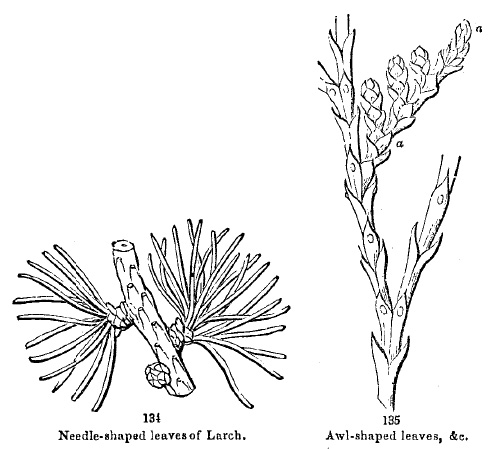

Needle-shaped leaves, such as those of Pine-trees and Larches (Fig. 134) These are long, slender and rigid, and often with little or no distinction of sides.
Awl-shaped or Subulate leaves are those which from a broadish base taper into a sharp and rigid point, like one sort of those of the Red Cedar and Arbor Vitae (Fig. 135, those on the larger branchlets).
Those on other branchlets, as at a, are shorter, blunt, and scale-shaped.
Thread-shaped or Filiform leaves, round and stalk-like, as those of the Onion.
Equitant leaves, like those of Iris (Fig. 64), which are folded together lengthwise, as may be seen at the base, where they override each other. They grow upright, with their faces looking horizontally, instead of having an upper and a lower surface, as most leaves do.



152. Stipules, as already explained (120), are a pair of appendages at the base of the leaf, one on each side. These often grow fast to the base of the leafstalk, as they do in the Rose and in Clover (Fig. 136; st, the stipules).
Or they may join with each other and form a kind of sheath round the stem, as they do in the Buttonwood and in Polygonum (Fig. 137).
Many leaves have no stipules at all. In many cases they fall off very early, especially those that serve for bud-scales, as in Magnolia.
153. The Arrangement of Leaves on the stem has already been explained as to the two principal ways (59). Leaves are either
Alternate, when they follow each other one by one, as in the Morning-Glory (Fig. 4) and the Linden (Fig. 83); or
Opposite, when in pairs, that is, two on each joint of stem, one opposite the other, as in Maples (Fig. 84). To these may be added a third; but less common arrangement, viz. the
Whorled, where there are three, four, or more leaves on the same joint of stem, forming a circle or whorl, as in Madder and Bedstraw (Fig. 137 l). But this is only a variety of the opposite mode.
Analysis of the Section.
119. Leaves, their varieties, why useful to learn. 120. Their parts: Blade, Footstalk, Stipules. 121. Simple and Compound. 122. Structure and Veining of leaves: woody or fibrous part; cellular tissue or green pulp; Epidermis or Skin. 123. Ribs. 124. Veins and Veinlets; Nerves, so called. 125. Two kinds of veining. 126. Netted-veined or Reticulated. 127. Class of plants that have this kind of veining. 128. Parallel-veined or Nerved; class of plants that have this kind of veining. 129. Both kinds of two sorts. 130. Feather-veined or Pinnately veined. 131. Radiate-veined or Palmately veined.
132 Shapes of leaves enumerated; as to general outline. 133. Those that taper downward. 134,135. Intermediate shapes, how expressed. 136. Shapes depending upon the base. 137. Forms of apex. 138. As to margin or toothing, &c. 139. Lobing or division. 140. How this is related to the veining; how both the kind of lobing and the number of parts may be expressed, 141, so that a short phrase will describe the leaf completely. 142. All the various terms apply as well to other parts, as to calyx, corolla, petals, &c.
143. Compound Leaves; Leaflets. 144. The two kinds. 145. Pinnate leaves. 146. Palmate or Digitate. 147. Varieties of pinnate leaves. 148. Number of leaflets. 149. Also of palmate leaves; why their leaflets are generally fewer than those of pinnate leaves. 150. Twice or thrice compound and decompound leaves.
151. Leaves without distinction of blade and footstalk; Needle-shaped; Thread-shaped; Awl-shaped; Equitant. 152. Stipules, often united with the footstalk, or with each other.
153. The arrangement of leaves on the stem: the three modes, viz, alternate, opposite, whorled.

